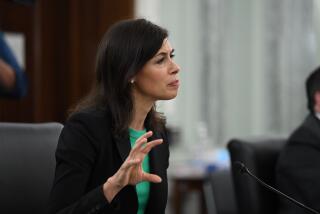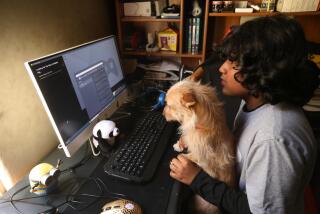Digital TV transition expected run much more smoothly
WASHINGTON AND LOS ANGELES — Federal officials and broadcasters are hoping that today’s switch to all-digital broadcast television for stations in Los Angeles and around the country will run as smoothly as a scripted sitcom and not turn into the ultimate reality-TV mess.
The odds of an orderly transition have improved, they said, because of a four-month delay pushed by the Obama administration at the beginning of the year.
“We are in much better shape,” said Joel Kelsey, a policy analyst for Consumers Union.
Fearful of a backlash from nearly 6 million unprepared Americans who stood to lose their broadcast TV signals, President Obama and Congress put off the long-planned digital transition scheduled for Feb. 17 until today for most of the country.
They also poured an additional $650 million into the switch, including reducing a backlog of 4 million requests for $40 government coupons to subsidize the purchase of special digital converter boxes so that older televisions could receive the new signals.
And the Obama administration made a smooth transition a priority, a major shift from what critics said was an underfunded and disorganized effort by the Bush administration.
Broadcasters also have continued their outreach efforts, trying to avoid losing precious viewers. In Los Angeles, Univision’s Spanish-language KMEX-TV Channel 34 dispatched teams of employees and volunteers called the Escuadron Digital, or Digital Squad, to senior centers to educate older viewers. Walt Disney Co.’s KABC-TV Channel 7 has been beaming an electronic message warning of today’s transition from analog to digital television on its towering sign off the Golden State Freeway.
One of NBC Universal’s Spanish-language stations in Los Angeles, KWHY-TV Channel 22, provided a booth to the Federal Communications Commission at last month’s Fiesta Broadway event in downtown L.A., which was attended by hundreds of thousands of Latinos. The other NBC Spanish-language station, Telemundo’s KVEA-TV Channel 52, helped coordinate with local radio station contests that gave away free digital converter boxes to listeners.
The goal of all those efforts has been to turn the digital TV conversion into a non-event for most Americans, similar to another technological milestone: the much-feared but largely inconsequential Y2K computer bug at the turn of the century.
Federal officials have touted the benefits of the delay, namely that more than half of those unprepared viewers who depend on over-the-air TV are now ready for the switch. Some of the nation’s TV stations were allowed to turn off their analog programming early -- about 42% of them have done so since February. The remainder will do so today. Viewers with cable, satellite or phone company TV service are unaffected.
But about 2.8 million people nationwide, including more than 250,000 in the Los Angeles region, are likely to experience firsthand how different this transition might be from Y2K. When they turn on their TVs on Saturday morning, they probably will see a temporary analog message saying they need to upgrade their equipment -- or simply a blank screen.
“Had we gone ahead in February, we would have had a consumer backlash of considerable magnitude,” said acting FCC Chairman Michael J. Copps, who has been focused on the transition ever since Obama elevated him to the position in January. “Now there will still be some level of disruption, there’s no question about that, but it’s a lot better than it would have been.”
Local TV station executives in Los Angeles say they are particularly worried about elderly viewers, the poor and those who primarily speak Spanish.
Spanish speakers who live in L.A. have more than six free over-the-air channels, including the top-rated Univision KMEX and Telemundo KVEA, to choose from and have little reason to subscribe to satellite or cable TV, which can cost $40 or more a month.
“We have been gearing up for this for the last 18 months,” said Maelia Macin, general manager of KMEX. “We know that we serve as a lifeline for many of our viewers, and the primary focus of our station is to educate our community.”
A study this week by Nielsen Co. found that Los Angeles and other cities in the Southwest, those with large Latino populations, are less prepared for the switch than other areas of the U.S. Federal officials say that is the region they are most concerned about and have been focusing their efforts.
The switch to all-digital broadcast TV has been in the works since 1987. The effort gained momentum after the 2001 terrorist attacks, as lawmakers pressed for an end to analog broadcasts so that some of those airwaves could be allocated to emergency agencies to develop new interoperable communications.
Digital TV offers clearer pictures, better sound and the ability for broadcasters to send out additional programs on new sub-channels. But there is a downside: Viewers on the fringes of a station’s broadcast area, or without good antennas, might not get the new signal.
In 2006, Congress set Feb. 17, 2009, as the date for broadcasters to turn off their analog signals and allocated $1.5 billion to provide coupons for converter boxes, anticipating billions in revenue from leasing use of most of the analog airwaves. The government auction for those leases brought in $19.6 billion last year from telecommunications companies such as Verizon Wireless, which plan to use them to deliver new mobile services.
But the conversion date was somewhat arbitrary -- lawmakers wanted to wait until after this year’s Super Bowl to pull the plug.
Outreach efforts began in 2007, including a $1.2-billion public awareness initiative by the National Assn. of Broadcasters. But consumer groups and some Democratic lawmakers soon criticized the Bush administration’s efforts, which were run jointly by the FCC and the Commerce Department’s National Telecommunications and Information Administration.
Congress had allocated about $6.5 million to the two agencies for public outreach, far less than many thought was necessary. Congress last year boosted that amount by about $20 million.
Concerns that the outreach efforts were still inadequate exploded in January, when the Commerce Department agency that administered the coupon program ran out of money after a flood of requests as the deadline approached. Congress voted in early February to grant Obama’s request to delay the transition and provide more money for the coupon program and outreach.
Among the initiatives by the FCC: deploying 200 staff members around the country, instituting a 24-hour call center at (888) CALL-FCC, or (888) 225-5322, and contracting to provide in-home assistance for people unable to get their new equipment working.
Some Republicans said the delay was unnecessary and confusing. They also questioned the need for the additional federal money. But Kelsey, the Consumers Union policy analyst, said the extra time and funds have made a major difference.
“I think you’re still going to see a lot of homes in the dark for sure,” he said. “At the same time they have a clear place to turn and there’s a good infrastructure to deliver them assistance.”
--
meg.james@latimes.com
Times staff writer Alex Pham contributed to this report.
--
BEGIN TEXT OF INFOBOX
Details about the transition
Today, TV stations throughout the U.S. will turn off their analog signals, sending their broadcasts entirely via digital signals. All viewers, including those who already have digital converter boxes, will have to rescan in order to receive their stations.
CHANNELS AND TIMES
Some major Southern California stations and the times of their digital conversion:
KCBS Channel 2 - 1:10 p.m. today
KNBC Channel 4 - 11:30 a.m. today
KTLA Channel 5 - 10:45 p.m. today
KABC Channel 7 - Noon today
KCAL Channel 9 - 1:10 p.m. today
KTTV Channel 11 - Midnight today
KCOP Channel 13 - Midnight today
KSCI Channel 18 - 11:00 a.m. today
KWHY Channel 22 - 11:35 p.m. today
KCET Channel 28 - Midnight Thursday
KFTR Channel 29 - 11:27 p.m. today
KMEX Channel 34 - 11:59 p.m. today
KOCE Channel 50 - 11:30 p.m. today
KVEA Channel 52 - 11:35 p.m. today
KLCS Channel 58 - 3 p.m. today
KRCA Channel 62 - Midnight today
RESOURCES
On the Web: www.dtv.gov
By phone: (888) CALL-FCC or (888) 225-5322
To get a $40 coupon toward the purchase of a converter box: www.dtv2009.gov or call (888) 388-2009
To troubleshoot issues with antennas and signal strength: www.dtvanswers.com/dtv_antenna.html
Source: Times research
More to Read
The biggest entertainment stories
Get our big stories about Hollywood, film, television, music, arts, culture and more right in your inbox as soon as they publish.
You may occasionally receive promotional content from the Los Angeles Times.












